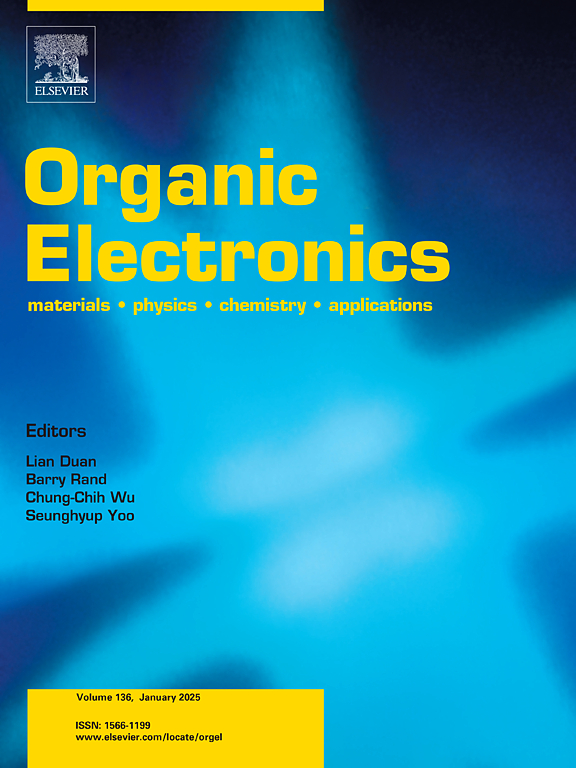Efficient greenish-blue thermally activated delayed fluorescence Zn complex for organic light emitting devices
IF 2.6
4区 工程技术
Q3 MATERIALS SCIENCE, MULTIDISCIPLINARY
引用次数: 0
Abstract
A greenish-blue zinc complex Zn(PhOBz)-PXZ with enhanced thermally activated delayed fluorescence (TADF) properties has been prepared from Zn(OAc)2 and 4PXZ2OHBz, a 2-(1H-benzimidazol-2-yl)phenol-based TADF ligand. The TADF phenomenon has been confirmed by time-resolved photoluminescence (TrPL) studies. The DFT calculations show spatially well-separated HOMO and LUMO in their ground states, along with a small energy splitting between the excited singlet (S1) and triplet (T1) states, in a good agreement with the TADF mechanism. Due to the high thermal stability of Zn(PhOBz)-PXZ, OLED devices can be fabricated by vacuum vapor deposition, and greenish-blue OLEDs with the maximum emission at 521 nm were successfully demonstrated. The maximum external quantum efficiency (EQEmax) of 10.6 %, with Commission Internationale de l’Eclairage (CIE) coordinates of (0.28, 0.47) were recorded. Zinc TADF complexes have the advantages of cost-effectiveness, greater abundance of natural resources, environmentally friendly metals, making them potential replacements for future precious metal emitters.

用于有机发光器件的高效绿蓝热激活延迟荧光锌配合物
以Zn(OAc)2和2-(1h -苯并咪唑-2-基)酚基TADF配体4PXZ2OHBz为原料,制备了具有增强热激活延迟荧光(TADF)性能的绿蓝色锌配合物Zn(PhOBz)- pxz。时间分辨光致发光(TrPL)研究证实了TADF现象。DFT计算表明,HOMO和LUMO在基态上空间分离良好,激发单重态(S1)和三重态(T1)之间存在较小的能量分裂,与TADF机制一致。由于Zn(PhOBz)-PXZ具有较高的热稳定性,可以通过真空气相沉积制备OLED器件,并成功地展示了最大发射波长为521 nm的绿蓝色OLED器件。最大外量子效率(EQEmax)为10.6%,国际照明委员会(CIE)坐标为(0.28,0.47)。锌TADF配合物具有成本效益高、自然资源丰富、金属环境友好等优点,是未来贵金属排放物的潜在替代品。
本文章由计算机程序翻译,如有差异,请以英文原文为准。
求助全文
约1分钟内获得全文
求助全文
来源期刊

Organic Electronics
工程技术-材料科学:综合
CiteScore
6.60
自引率
6.20%
发文量
238
审稿时长
44 days
期刊介绍:
Organic Electronics is a journal whose primary interdisciplinary focus is on materials and phenomena related to organic devices such as light emitting diodes, thin film transistors, photovoltaic cells, sensors, memories, etc.
Papers suitable for publication in this journal cover such topics as photoconductive and electronic properties of organic materials, thin film structures and characterization in the context of organic devices, charge and exciton transport, organic electronic and optoelectronic devices.
 求助内容:
求助内容: 应助结果提醒方式:
应助结果提醒方式:


